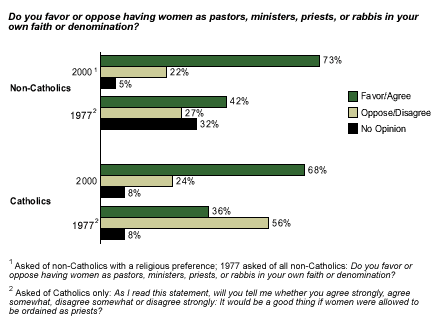Among the calls for reform brought on by the sexual abuse scandal that has rocked the Roman Catholic Church have been renewed arguments that women should be ordained as priests. The numbers of women in the clergy of all faiths have skyrocketed over the past two decades. In the United States today, one clergy member in every six is a woman. According to 2000 U. S. Bureau of Labor statistics data, the number of women who describe themselves as "clergy" is 50,922, an increase from 16,408 women in 1983. And in the last 25 years, both Catholics and non-Catholics have shifted toward an overall favorable view of women serving in the clergy.
When non-Catholics were asked in 1977* whether they favor or oppose having women as pastors, ministers, priests or rabbis in their own faith or denomination, only 42% said they favored it, while 27% opposed and 32% had no opinion. When asked in May 2000**, 73% of non-Catholics (with a religious preference) said they favor allowing women in the clergy, and only 22% were opposed.
In 1977, only 36% of Catholic respondents agreed that it was a good thing for women to be ordained as priests. By the year 2000, 68% said they favored allowing women to become members of the clergy. There is currently little difference between the numbers of men and women who feel this way; the May 2000 poll found that 70% of men and 72% of women (of all faiths) said they favored female clergy members.
The Rev. Sally Osmer, a Methodist minister ordained in 1974 and currently director of The Crisis Ministry, a large food pantry in central New Jersey, recalls those early years when women were beginning to enter the clergy. "I would say that in the '70s and '80s women entering seminaries and the ordained ministry in Protestant churches were very aware of being forerunners, and were more self-consciously identified with women's liberation issues," Osmer says. "In fact, for many of the early women, such identification was necessary in order to advocate for oneself to be treated equally and to survive in a male-dominated profession. My experience in those years was that people warmed to the idea of my ministry as they experienced it. If I was the one who married, baptized or buried their loved ones, then I became their minister."

Indeed, there are indications that women are particularly suited to the clergy. The most recent Gallup poll on religion*** found that women exhibit a higher level of religiosity than men in terms of beliefs, level of religious commitment and religious practice. A higher percentage of women (72%) than men (59%) believe that religion can answer all or most of today's problems, and a considerably larger proportion of women (68%) than men (48%) report that religion is "very important" in their own lives. Women (69%) are more likely to be members of a local church than men are (59%). They also attend church more regularly -- in the March 2002 poll, 48% of women reported attending church or synagogue in the last seven days while only 39% of men did so. These trends comparing the religiosity of men and women have been consistent in every Gallup measurement taken over the last six decades.
"My own daughter, who was born in 1981," Osmer notes, "has continuously had a woman as one of her ministers. She prefers women as preachers because they use examples that she understands and values."
*Results are based on telephone interviews with 969 national adults, aged 18 and older, conducted March 4-7, 1977. For results based on the total sample of national adults, one can say with 95% confidence that the margin of sampling error is ±3%.
**Results are based on telephone interviews with 1, 032 national adults, aged 18 and older, conducted May 23-24, 2000. For results based on the total sample of national adults, one can say with 95% confidence that the margin of sampling error is ±3%.
***Results are based on telephone interviews with 1,009 national adults, aged 18 and older, conducted March 18-20, 2002. For results based on the total sample of national adults, one can say with 95% confidence that the margin of sampling error is ±3%.
